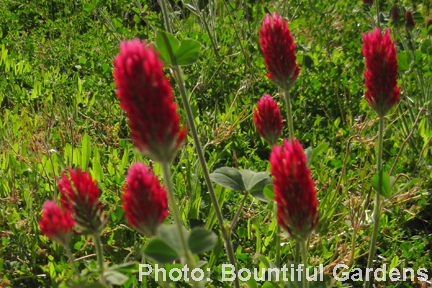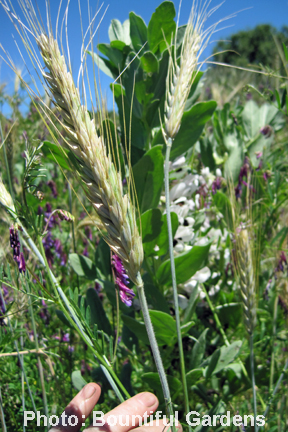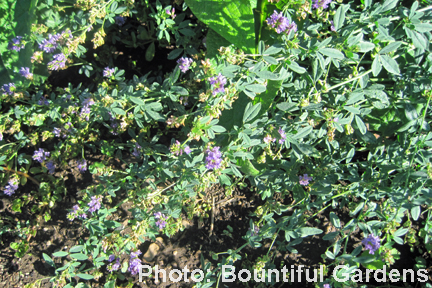
If you’re planning to grow only a few vegetables this winter — or even none at all — don’t leave your garden beds bare. Instead, consider sowing a cover crop to rejuvenate your soil.
Sometimes called compost crops or green manure, cover crops have been used for centuries to replenish nutrients, loosen up compacted soil, control erosion, inhibit weeds and provide habitat for beneficial insects.
The technique faded away in the 1950s when the use of fertilizers, herbicides and pesticides became widespread. But with recent interest in organic and sustainable growing techniques, cover crops are enjoying a resurgence in popularity.
Getting Started
Cover crops come in two flavors: warm-season and cool-season. In all but the largest home gardens, the cool-season types are more practical. That’s because our warm-season summer vegetables tend to take up a lot of room. Think sprawling melon vines, robust rustling cornstalks and bushy, full-bodied tomatoes. Every last square inch of soil is generally consumed by one edible or another.
Come the cool season, many of our crops, including leafy greens, carrots and radishes, can be planted more intensively. Growing these smaller edibles often leaves a fair amount of bare earth, which is perfect for sowing a cover crop.

As for what to grow: consider what you’d like to achieve. Legumes add nitrogen to the soil by grabbing it from the atmosphere and “fixing” it in nodules on their roots. Cool-season annual legumes include clover, vetch, field peas, alfalfa and bell or fava beans.
Grasses and cereal grains help to build the soil and boost fertility by adding organic material. They also improve tilth and fight erosion. While they can look a little straggly themselves, they help to crowd out weeds. Look for annual ryegrass, barley and oats.
Grow a mix if you’d like your cover crop to accomplish more than one of the above. For example, Bountiful Gardens, a mail-order nursery in Willits, California, offers a Compost Crop Mix containing wheat, vetch, rye and fava beans, while Peaceful Valley Farm & Garden Supply, also mail-order, has a Premium Soil Builder Mix composed of bell beans, BioMaster peas, yellow peas, purple vetch, hairy vetch and Cayuse oats.
In the Garden

Cover crops are grown from seed. It’s important to sow the cool-season annual types in September or October while daytime temperatures and soil temperatures are still warm, which boosts germination and gets the seedlings off to a strong start.
Here’s what to do:
• Rough up the soil with a stiff rake, garden fork or shovel.
• Smack any dirt clods to break them apart.
• Apply a specialized bacteria inoculant to any legume seeds.
• Scatter the seed at the rate suggested on the packet.
• Lightly rake in the seed to the recommended depth.
• Gently water the area.
• Mulch with a light layer of straw or shredded leaves, then water again.
• Keep the surface visibly moist for the first week.
Once the seeds sprout, start backing off on the water. As the seedlings begin to shade their own roots, ease off to once a week or so. When winter rains appear, stop watering entirely, unless a dry spell occurs.
Cool-season cover crops typically take five to six months to do their work and should be ready to be knocked down in March or April. But the weather ultimately governs their tenure. They may stall out during several weeks of cooler temperatures and rain, or speed up dramatically with a series of unseasonably warm, dry days.
Harvest Time

Regardless of the calendar, your cover crop’s time is up when it begins flowering and its roots are still fresh and pliable.
That point is critical. I once made the mistake of letting fava beans complete their life cycle, including setting seed and withering away. Then, digging into the soil, I discovered thick, fibrous roots. While it’s best to wait three to six weeks between harvesting a cover crop and planting new vegetable seeds or seedlings, no way were those tough ropes of roots going to decompose within a reasonable period of time. To plant new vegetables, I had to yank out the roots, which included their nitrogen nodes. Doing so defeated the purpose of planting the favas. Plus, it was extra work.
To harvest your cover crop, mow it, weed whack it or hack it to the ground. If you’ve grown vetch, trailing peas or any thick-stemmed plants, cut them up so they’ll break down faster. Let the spent pieces dry out for a week or two, then till them into the soil. Or rake up the dried top growth and add it to your compost pile. Later on, you can mix the finished compost into your garden soil, returning all those nutrients and goodness to the earth.
≈
This article was first published in the Fall 2012 issue of Central Coast Farm & Ranch.
Copyright, Joan S. Bolton. All rights reserved. Reproduction of text or photos in any form is prohibited without written permission.
≈
